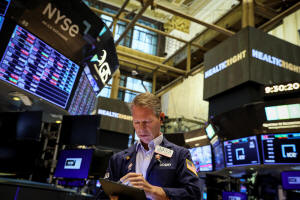Marketmind: Energy rescues
 Send a link to a friend
Send a link to a friend
 [September 06, 2022]
A look at the day ahead in U.S. and global
markets from Mike Dolan. [September 06, 2022]
A look at the day ahead in U.S. and global
markets from Mike Dolan.
While U.S. markets idled for Labor Day and digested the August jobs
report, attention was squarely on Europe's energy crunch and how both
European Union governments and a new UK Prime Minister would cope with a
total Russian gas cutoff.
Monday was jarring for stocks and currencies in the region, with little
realistic prospect of Russia resuming gas supplies through the Nord
Stream 1 pipeline any time soon.
But although they remain three times the levels at the start of this
year, European natural gas prices did not return to last month's peaks
despite Moscow's latest move and have retreated again since - with the
Dutch benchmark now down about 30% over the past two weeks.
Similarly, crude oil prices failed to make any significant gains even in
the face of OPEC's decision Monday on a small cut to output, and remain
down almost 25% from mid-year peaks.

For all the thorny supply problems, more restrained energy prices
reflect inevitable global recession fears, a wave of European price caps
and industry supports, and coordinated moves to reduce energy use and
step up substitution to alternatives.
Germany announced some 65 billion euros ($65 billion) of supports on
Monday, while new UK Prime Minister Liz Truss was reported to be
earmarking a package of more than 100 billion pounds of both energy
price caps as well as shielding of household and businesses.
The mood in global stock markets was calmer on Tuesday as a result, with
European and UK indices steady to firmer and Wall Street futures up
about half a percent ahead of the open.
China's stocks outperformed, with policymakers signalling a renewed
sense of urgency on Monday for steps to shore up the flagging economy.
But the yuan continued to slip to 2-year lows, despite China's central
bank decision to cut FX reserve requirements to brake its fall.

[to top of second column] |

A trader works on the floor of the New
York Stock Exchange (NYSE) in New York City, U.S., August 29, 2022.
REUTERS/Brendan McDermid

Domestically-focussed UK midcap stocks outperformed in Europe on hopes for the
long-awaited government energy plan. But, absorbing the prospect of such high
government spending alongside likely tax cuts, UK government bonds continued to
lag, and 2-year and 10-year gilt yields remained at 14-year and 8-year highs
respectively.
The U.S. dollar continued to push new highs on many fronts. But with relative
interest rate moves in focus ahead of possible 75 basis point (bp) hikes from
both the European Central Bank and Bank of England over the next two weeks, the
dollar gains on Tuesday were concentrated in Asia.
The greenback hit a new 24-year high of 141.73 Japanese yen, and a fresh 2-year
high against China's yuan. But it fell back from Monday's new peaks against the
euro and sterling and that saw its DXY index also retreat from Monday's 20-year
peak.
Australia's dollar slipped back to its lowest since July after the Reserve Bank
of Australia raised its main policy rate by 50 bps - its fifth move since May
and signalling more to come, but significantly now a slower clip than expected
at the Federal Reserve or from Europe's central banks.
Key developments that should provide more direction to U.S. markets later on
Tuesday:
* US ISM and S&P Global August service sector and composite business surveys

* IMF head Kristalina Georgiev speaks at Bruegel think-tank conference in
Brussels on global fragmentation
* Central Bank of Chile holds monetary policy committee meeting
($1 = 1.0045 euros)
(By Mike Dolan, editing by XXX mike.dolan@thomsonreuters.com. Twitter: @reutersMikeD;
Editing by Mark Potter)
[© 2022 Thomson Reuters. All rights
reserved.]This material may not be published,
broadcast, rewritten or redistributed.
Thompson Reuters is solely responsible for this content. |